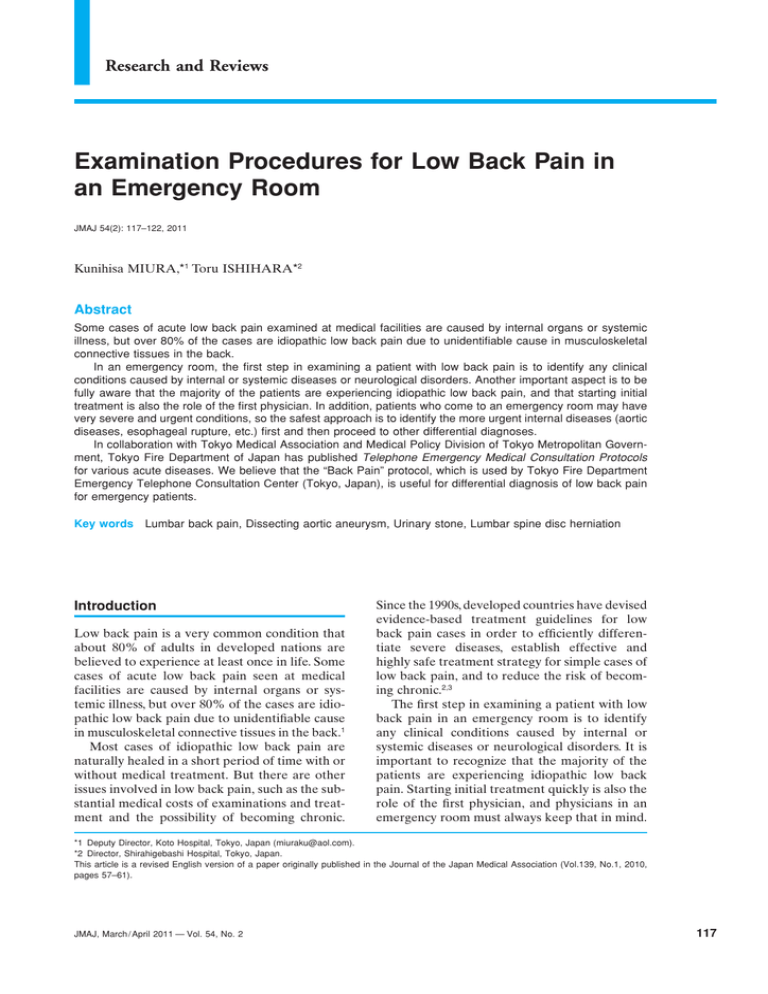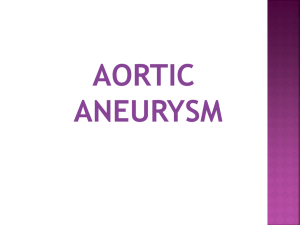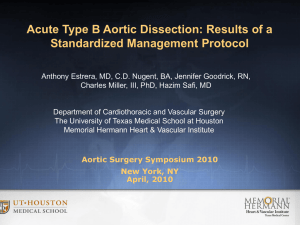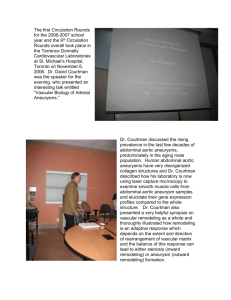Examination Procedures for Low Back Pain in an Emergency Room
advertisement

Research and Reviews Examination Procedures for Low Back Pain in an Emergency Room JMAJ 54(2): 117–122, 2011 Kunihisa MIURA,*1 Toru ISHIHARA*2 Abstract Some cases of acute low back pain examined at medical facilities are caused by internal organs or systemic illness, but over 80% of the cases are idiopathic low back pain due to unidentifiable cause in musculoskeletal connective tissues in the back. In an emergency room, the first step in examining a patient with low back pain is to identify any clinical conditions caused by internal or systemic diseases or neurological disorders. Another important aspect is to be fully aware that the majority of the patients are experiencing idiopathic low back pain, and that starting initial treatment is also the role of the first physician. In addition, patients who come to an emergency room may have very severe and urgent conditions, so the safest approach is to identify the more urgent internal diseases (aortic diseases, esophageal rupture, etc.) first and then proceed to other differential diagnoses. In collaboration with Tokyo Medical Association and Medical Policy Division of Tokyo Metropolitan Government, Tokyo Fire Department of Japan has published Telephone Emergency Medical Consultation Protocols for various acute diseases. We believe that the “Back Pain” protocol, which is used by Tokyo Fire Department Emergency Telephone Consultation Center (Tokyo, Japan), is useful for differential diagnosis of low back pain for emergency patients. Key words Lumbar back pain, Dissecting aortic aneurysm, Urinary stone, Lumbar spine disc herniation Introduction Low back pain is a very common condition that about 80% of adults in developed nations are believed to experience at least once in life. Some cases of acute low back pain seen at medical facilities are caused by internal organs or systemic illness, but over 80% of the cases are idiopathic low back pain due to unidentifiable cause in musculoskeletal connective tissues in the back.1 Most cases of idiopathic low back pain are naturally healed in a short period of time with or without medical treatment. But there are other issues involved in low back pain, such as the substantial medical costs of examinations and treatment and the possibility of becoming chronic. Since the 1990s, developed countries have devised evidence-based treatment guidelines for low back pain cases in order to efficiently differentiate severe diseases, establish effective and highly safe treatment strategy for simple cases of low back pain, and to reduce the risk of becoming chronic.2,3 The first step in examining a patient with low back pain in an emergency room is to identify any clinical conditions caused by internal or systemic diseases or neurological disorders. It is important to recognize that the majority of the patients are experiencing idiopathic low back pain. Starting initial treatment quickly is also the role of the first physician, and physicians in an emergency room must always keep that in mind. *1 Deputy Director, Koto Hospital, Tokyo, Japan (miuraku@aol.com). *2 Director, Shirahigebashi Hospital, Tokyo, Japan. This article is a revised English version of a paper originally published in the Journal of the Japan Medical Association (Vol.139, No.1, 2010, pages 57–61). JMAJ, March / April 2011 — Vol. 54, No. 2 117 Miura K, Ishihara T Table 1 Items to check for patients with low back pain in medical history and physical examination Medical History • Current History Inducing factor: External injury Progression: Cataplectic, acute, or chronic At rest, on moving, on exertion, or at night when sleeping A change in the site of pain Location: Thoracodorsal, back, or lower back region; right, center, or left side Accompanying symptoms: Pain in the head or neck, chest pain, or stomach pain Neurological symptoms of upper and/or lower limbs, intermittent claudication, or vesicorectal dysfunction Vomiting, fever, or syncope • Past history: Cancer, infectious disease, diabetes, or hypertension • History of medication: Steroids Physical Examination • Vital signs • Physical examination findings Systemic (and other related) findings: Head, chest, abdomen, or rectal examination Direct examination of the back: Visual examination, percussion and palpation of the spinous processes, or palpitation of the paraspinal muscles Neurological examination: Movement, sensations, tendon reflex, or pathological reflex Nerve root stimulation test: Straight leg raising (SLR) test [Extracted from Kamei (2005).4 ] Table 1 4 shows the items to check in medical history and physical findings during the first examination when examining a patient with low back pain. Medical Examination Algorithm for Low Back Pain Patients in an Emergency Room According to epidemiological research on patients receiving primary care in the USA in the 1990s, less than 2% of patients with low back pain had internal diseases.1,5 However, emergency patients are more likely to have increased severity and urgency, so it is reasonable to assume that prevalence rate of internal diseases is higher among emergency patients. The safe approach is to identify the cases with more urgent internal diseases first and then proceed to other differential diagnoses. In Japan, Tokyo Fire Department has published Telephone Emergency Medical Consultation Protocols for various acute diseases in collaboration with Tokyo Medical Association and Medical Policy Division of Tokyo Metropolitan Government.6 The “Back Pain” protocol, which has been 118 shown to be useful for low back pain cases and is already used by Tokyo Fire Department Emergency Telephone Consultation Center, is shown in Table 2. Differential diagnosis of internal diseases Pain caused by internal or systemic diseases are not alleviated by resting or sleeping. Another characteristic is that change in posture does not alter the pain. Commonly, the low back pain due to internal or systemic disease is accompanied by other associated symptoms and inducing factors, which are specific to the disease. The site of the pain is also specific to the disease. Aortic diseases Dissecting aortic aneurysm Dissecting aortic aneurysm is a condition in which the dissection of the aortic media tears the aortic wall into 2 layers. It results in sharp pain in the back, and the patient occasionally presents symptoms of shock, fainting, and loss of consciousness. Depending on the extent of the dissection, dissecting aortic aneurysm may accompany cardiac tamponade, myocardial ischemia, aortic regurgitation, or cerebral infarction. When the JMAJ, March / April 2011 — Vol. 54, No. 2 EXAMINATION PROCEDURES FOR LOW BACK PAIN IN AN EMERGENCY ROOM Table 2 The back pain protocol, from Telephone Emergency Medical Consultation Protocols 6 (Colloquial expressions) “My back hurts,” “My backbone hurts,” etc. [Possible diseases] Kidney stones, ureteral stones, pyelonephritis, pancreatitis, duodenal ulcer, aortic dissection, ruptured abdominal aortic aneurysm, etc. Q7 Confirmation of aspects related to the patient’s main complain (since when, duration, severity, location, OTC medicine, etc.) Q8 Do any of the following apply? Yes If “yes” to Q8, please call an ambulance. 1. Does your chest hurt? □ 2. Did the pain emerge suddenly and getting worse? (Regardless of the age) □ 3. Does the location of strong pain move? □ Aortic dissection 4. Does the pain feel like tearing or ripping? □ Aortic dissection 5. Did your feet suddenly go numb? [Or] Did the heaviness in your feet (adynamia of lower limbs) worsen? [Or] Can you move your feet at all? □ 6. Was there any blood in your urine? [And] Do you experience severe pain when you urinate? □ 7. Do you leak feces or urine (incontinence)? □ Q9 Do you any of the following apply? Yes Kidney stones, urinary stones Neurological disorders Refer to: 1. Do you feel nauseous? [Or] Have you vomited? [Or] Do you have a fever? □ Internal medicine 2. Is it hard to urinate? [Or] Does nothing come out when you go to the bathroom (prolonged urination problem)? □ Urology 3. Do you go to the bathroom frequently? [Or] Does it hurt when you urinate? □ Urology 4. Did you suddenly feel pain after sitting for a long time [or] remaining in the same position [or] travelling? □ Internal medicine Q10 Do any of the following apply? Yes Refer to: 1. Do you feel pain radiating from your buttocks (hips) down to your feet? □ Orthopedics 2. Is it hard to walk? □ Orthopedics 3. Do pain relievers have any effect? □ Internal medicine 4. Have you ever been injured within the last 2 days? [Or] Have you been in an accident? □ Surgery/Orthopedics 5. Have you had cancer or diabetes? [Or] Are you being treated for one of these? □ Internal medicine (Primary care physician) 6. Have you lost weight recently? □ Internal medicine Q11 Do you any of these apply? Yes Refer to: 1. Do you have chronic back pain? Have you had a back operation? Have you had kidney stones or any renal disease? □ Internal medicine 2. Do you have pain anywhere other than your back (not including radiating pain)? [Or] Do you have mild pain when you move that is not strong enough to restrict movement? □ Internal medicine 3. Do you have a fever? □ Internal medicine Q12 Reconfirm the following. Yes 1. Are you an elderly (over 65)? [Or] A child (under 15)? [Or] Pregnant? □ 2. Can you walk at all? Or do you lack a way to move about? □ 3. Do you have high blood pressure? □ Consider increasing the degree of urgency selected, or consult a physician. If none of the above items apply (Consult a physician as necessary): At present, the case is not urgent. However, if the symptoms worsen or persist without change, or if other symptoms appear, we recommend that you visit a clinic or hospital. [Extracted from Production Committee for Emergency Medical Consultation Protocols, Tokyo Medical Association Emergency Medicine Committee, ed. (2008).6 ] JMAJ, March / April 2011 — Vol. 54, No. 2 119 Miura K, Ishihara T patient describes a tearing pain in the chest and the back, the physician should carefully monitor the loss of pulse in the carotid artery and/or proximal upper limb, the blood pressure difference of 20 mmHg or greater between the upper left and right limbs,7 or an enlarged image of the mediastinum or aorta in a plain X-ray. True aortic aneurysm True aortic aneurysm is a condition in which the aortic diameter expands more than 50% in a saccular or fusiform shape. This is often caused by the weakening of the vascular wall due to arterial sclerosis, external injury, inflammation, infection, or congenital metabolic abnormality such as Marfan syndrome. It is usually asymptomatic, but the patient may present a sustained dull pain as a pressure symptom when the condition is worsening. Rupture or impending rupture of the aorta is characterized by 3 main symptoms: stomach and back pain, low blood pressure, and an abdominal pulsatile mass. The abdominal aorta is the retroperitoneal organ, and low back pain often occurs depending on the direction of the rupture. Abdominal masses accompanied by inflammatory aortic aneurysms and low back pain are also observed. Cases of aortic aneurysm that involved lumbar vertebra invasion, which had been treated as chronic low back pain, have also been reported.8 Merely 20% of patients with ruptured aneurysms arrive at medical facilities alive, and the survival rate with surgery is only about 50% even when blood pressure is maintained temporarily.9 Internal diseases that involve thoracoabdominal organs Esophageal rupture Esophageal rupture is a condition in which all esophageal layers suddenly rupture. This often occurs after an increase in abdominal muscle pressure, such as severe emesis after overeating and overdrinking, straining, coughing, or bowel movements. The esophageal wall is thought to rupture as a result of a sudden rise in pressure within the esophagus, but in some cases there is apparently no inducing factor. In many cases, emesis induces severe pain in the chest and back, shock, respiratory distress, fevers, hematemesis, and/or subcutaneous emphysema. Pancreatitis Pancreatitis typically appears as pain in the epigastrium and/or upper left abdomen, often 120 accompanied by back pain, nausea and emesis. The most common causes are alcohol intake and gallstones, but approximately 20% cases are idiopathic. Cholecystitis and cholelithiasis Cholecystitis and cholelithiasis are often accompanied by pain from the right hypochondrium to the epigastrium, radiating pain to the right back and right shoulder, and emesis. Fever is also observed in cholecystitis. Kidney and urinary tract disease Among emergency outpatients with lower back pain, ureteral stones are very frequently the cause. But the prevalence rate peaks in the 30s to 60s,10 and it not very common among the elderly. With elderly patients, life-threatening diseases such as ruptured abdominal aortic aneurysm and kidney infarction can be mistaken for ureteral stone. Thus physicians should be cautious even if ureteral stones are clinically suspected. Spinal cord and vertebral diseases Many elderly patients are experiencing acute exacerbation of spondylosis deformans or osteoporosis or a fresh vertebral compression fracture, but an infectious diseases and metastatic spinal tumor are also fairly common. Diagnosis is relatively simple when the patient exhibits fully developed pathological condition. However, the initial diagnosis is not always easy, since the first symptoms are often masked as vague pains and the simultaneous changes that occur as the spine ages.11 The physician must remember to examine the presence of bone fractures, malignant tumor, infections, and pathological changes in the spine that cause neurological symptoms —all of which must not be overlooked. Fractures of the thoracic and lumbar vertebrae often appear in the thoracolumbar junction for anatomical reasons. In the initial diagnosis, it is important to differentiate between stable injuries and unstable injuries. One useful indicator for this is the Denis’s three column theory, which states that the fracture of 2 or more columns including the middle column results in instability. Patients with compressed fractures commonly complain of pain in the lower lumbar region. But in reality, they often have a fracture in the thoracolumbar joint, which must not be overlooked. Compressed fractures in osteoporosis can occur even without external injuries. The risk of com- JMAJ, March / April 2011 — Vol. 54, No. 2 EXAMINATION PROCEDURES FOR LOW BACK PAIN IN AN EMERGENCY ROOM pressed fractures is also high among patients who take oral steroids. Among cases of malignant vertebral tumor, metastatic cares are overwhelmingly more common than primary cases. The common primary focus includes the breast, lungs, prostate, kidney and digestive organs. Malignant vertebral tumor should be suspected when the patient has a history of cancer, unexplainable weight loss, or pain at rest or night. In many cases, sudden exacerbation of pain or paralysis develops when a pathological fracture occurs at the tumor site. Multiple myeloma is one of the most frequent types of primary vertebral tumors, and most of the pain is felt in the lower back. Among infectious diseases, pyogenic spondylitis is accompanied by the onset of fever and is characterized by the low back pain that persists even at rest. When examining patients with urinary tract infections, skin infections, catheterization, or immunodeficiency, pyogenic spondylitis should be suspected first. In addition, the possibility of epidural tumors is important to remember after epidural anesthesia and spinal operations, which can result in irreversible neural damage if not discovered early. If the patient has chronic dull pain, tuberculous spondylitis is another possibility. Among hemorrhagic diseases, although rare, spinal epidural hematoma is a very important disease that must be identified through differential diagnosis. It is frequently seen among patients who have a recent history of external or spine injury or are currently undergoing anticoagulant therapy. The first sign is the sudden development of severe back pain. Pressure symptom on the spinal cord indicates an increase in hematomas. Disc hernia usually involves the development of acute lumbago as the first symptom and is accompanied by sciatica. About 95% of lumbar disc hernias are L5 or S1 nerve root damage. The SLR test is very sensitive, but it is non-specific. Central herniation that involves a large intervertebral disc causes cauda equine syndrome, which symptoms include motor paralysis of both legs, sensory deficit in the perianal region, flaccidity of the anal sphincter muscle, and dysuria. In case of cauda equine syndrome, rapid decompression is essential. Spinal canal stenosis is often seen in elderly people, presenting a broad range of symptoms since the lesion involves multiple vertebrae. Pain and numbness occur in one or both legs, but the JMAJ, March / April 2011 — Vol. 54, No. 2 flexion of the spine reduces the stenosis and alleviates the symptoms. Intermittent claudication, in which pain appears as a result of walking, is well known, but it can be differentiated from arteriosclerosis obliterans because symptoms appear in the legs even when standing upright. Tests Blood and urine tests When inflammatory diseases of the internal organs or spine are suspected, blood tests should be conducted, such as total leukocyte count and differential counts, CRP, and ESR. A urine test should be given if ureteral stones or pyelonephritis are suspected. Ureteral stones do not necessary yield negative results in a urine occult blood test, and conversely positive results does not rule out the possibility of non-urological diseases. Digestive tract disorders such as acute appendicitis and ruptured abdominal aortic aneurysm can also yield positive results for urine occult blood. Imaging tests If the patient’s medical history and/or physical examination finding suggest internal diseases, the thoracoabdominal X-ray is often conducted. Lately, the emergence of many other kinds of clinical imaging methods has led to the disregard of detailed radiogram interpretations. Nevertheless, physicians should make effort to interpret as much information as possible from simple and minimally invasive tests. At the same time, ultrasound examinations can also be extremely effective for emergency patients, and may even provide a definite diagnosis. Recently, portable ultrasound has become more common, and ultrasound examination in an emergency room is likely to increase in the future. But examinations in an emergency room are subject to time constraint. For effective use of ultrasound, it is important to narrow down the suspected diseases from the patient history and physical examination so that the ultrasound needs to be conducted only on specific areas. Transthoracic echocardiography is helpful in diagnosing aortic diseases other than ischemic heart disease. In Stanford-types of acute aortic dissection, ultrasounds can confirm not only pericardial effusions and aortic valve regurgitation but also a flap in the aortic root. However, there are also cases of false-positives resulting from 121 Miura K, Ishihara T artifacts. Abdominal ultrasound examination can be effective in assessing a dissection or aneurysm of the abdominal aorta. Evaluation for hydronephrosis is common when ureteral stones are suspected, but hydronephrosis is often obscure in the acute stage. Contrast CT is required to determine the presence of aortic diseases or for detailed evaluation. On the other hand, in recent years plain CT has been shown to be effective in evaluating for ureteral stones, and has been used more often. If there is a high probability of spinal diseases, physicians often take a plain X-ray of the thora- columbar spine for emergency patients. CT and MRI are useful for a thorough examination, but patients with lumbar disc or other abnormalities are often asymptomatic,1 so physicians must carefully interpret the findings while referring to the patient’s history and physical examination as well. Recently CT has been shown to be better suited to the evaluation of bone structure than MRI, and is used more often. MRI is highly sensitive in detecting infectious diseases, metastatic tumors, and neural tumors. CT and MRI show the same degree of accuracy in detecting disc hernias and spinal canal stenosis.12 References 1. Deyo RA, Weinstein JN. Low back pain. N Engl J Med. 2001; 344:363–370. 2. Bigos S, Bowyer O, Braen G, et al. Acute low back problems in adults. Clinical practice guideline No. 14. Rockville: Agency for Health Care Policy and Research, Public Health Service, U.S. Department of Health and Human Services; 1994. AHCPR Publication No. 95-0642. 3. Koes BW, van Tulder MW, Ostelo R, et al. Clinical guidelines for the management of low back pain in primary care: an international comparison. Spine. 2001;26:2504–2513. 4. Kamei T. Back pain. The Japanese Journal of Acute Medicine. 2005;29:1819–1823. (in Japanese) 5. Hart LG, Deyo RA, Cherkin DC. Physician office visits for low back pain. Frequency, clinical evaluation, and treatment patterns from a U.S. national survey. Spine. 1995;20:11–19. 6. Production Committee for Emergency Medical Consultation Protocols, Tokyo Medical Association Emergency Medicine Committee, ed.; Japanese Association for Acute Medicine, supervised. Telephone Emergency Medical Consultation Protocols. Tokyo: Herusu Shuppan, Co., Ltd.; 2008. (in Japanese) 122 7. Von Kodolitsch Y, Schwartz AG, Nienaber CA. Clinical prediction of acute aortic dissection. Arch lntern Med. 2000;160:2977– 2982. 8. Edwards JZ, Weiner SD. Chronic back pain caused by an abdominal aortic aneurysm: case report and review of the literature. Orthopedics. 2003;26:191–192. 9. Hallin A, Bergqvist D, Holmberg L. Literature review of surgical management of abdominal aortic aneurysm. Eur J Vasc Endovasc Surg. 2001;22:197–204. 10. Yoshida O, Terai A, Ohkawa T, et al. National trend of the incidence of urolithiasis in Japan from 1965 to 1995. Kidney Int. 1999;56;1899–1904. 11. Nakayama Y, Shirai H. Points to note in geriatric emergency by symptoms—acute pain in the back and the lower back. Geriatr Med. 1999;37:1471–1475. (in Japanese) 12. Thornbury JR, Fryback DG, Turski PA, et al. Disk-caused nerve compression in patients with acute lowback pain: diagnosis with MR, CT myelography, and plain CT. Radiology. 1993;186:731– 738. JMAJ, March / April 2011 — Vol. 54, No. 2






